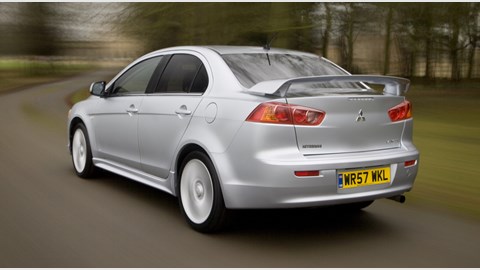While the new Lancer Evo X hoovers up all the headlines, Mitsubishi’s ‘standard’ new Lancers are getting ignored. And it’s a pity because the diesel in particular is worth a closer look – and no we’re not kidding.
The Lancer’s new platform, shared with the Outlander and co-developed with the former DaimlerChrysler corporation is well engineered, the standard kit is impressive and the styling has gone from oh dear to oh my!
It’s a handsome car – and potential buyers will be seduced by its looks – but the (non-Evo) Lancer has the unenviable job of erasing memories of the previous-generation car, surely the most dreary vehicle since, well, ever.
That’s a tough job. Can the new Mitsubishi Lancer really score some new fans?
Well, first impressions are good. Out goes the old Lancer’s almost laughably harsh interior plastics and in comes some fine, soft-touch materials. Push and prod the new dash and there’s a pleasing tactile quality unheard of on any Mitsubishi thus far. The touch-screen HDD sat-nav is excellent (standard on the GS4) and the controls feel solid and weighty – but not up to Civic/Focus standards. It’s a fine interior, if aesthetically unspectacular.
Standard kit on the GS4 model includes a 30GB music server, heated leather seats, climate control, iPod input and an on-board computer that allows the driver to personalise interior light delays, wing mirror retraction and wiper operation. IT geeks will love it.
How does the Lancer feel out on the road?
Mitsubishi has tried to close the gap between the sporting and non-sporting Evos; the result is a ‘sport-tuned’ chassis on the GS3 and GS4 models. These models even look like an Evo X thanks to the 18inch wheels, body kit and rear wing…
‘Sport-tuned’ means thicker anti-roll bars, stiffer dampers and even a strut-brace. Naturally the Lancer feels sporty on the road with decent grip, body control and agility thanks mostly to a new multi-link suspension set up at the rear, but the diesel’s comparative lack of performance jars with the chassis sportiness. We can’t help thinking a compromise chassis of 17-inch wheels and thinner anti roll bars would better suit the diesel’s character.
What about the diesel engine?
Evo aside, the direct injection, turbocharger diesel is the fastest Lancer of them all. It’s not that fast though; top speed is a reasonable 130mph while 0-60mph comes up in around 10 seconds. Mid-range performance, thanks to 228lb ft is impressive and there’s a nice, meaty wedge of torque from just 1750rpm. However, the engine could benefit from some improved soundproofing – there’s too much diesel clatter making its way to the interior.
Verdict
Despite its dynamic failings and engine noise intrusion, there’s a lot to like about the Lancer diesel. It offers great looks, tons of kit, a big boot and typical strong Mitsubishi reliability. It is, in other words, completely, utterly different to the outgoing model.
It’s by no-means a class-leading car, but Mitsubishi has been smart to proposition the Lancer between classes – it’s Vectra/Mondeo sized but its pricing is more Astra/Focus league. You need to try a Focus or a Civic before you commit yourself to the Mitsubishi, but if you want something just that little bit different, the Lancer is indeed worth a look.


